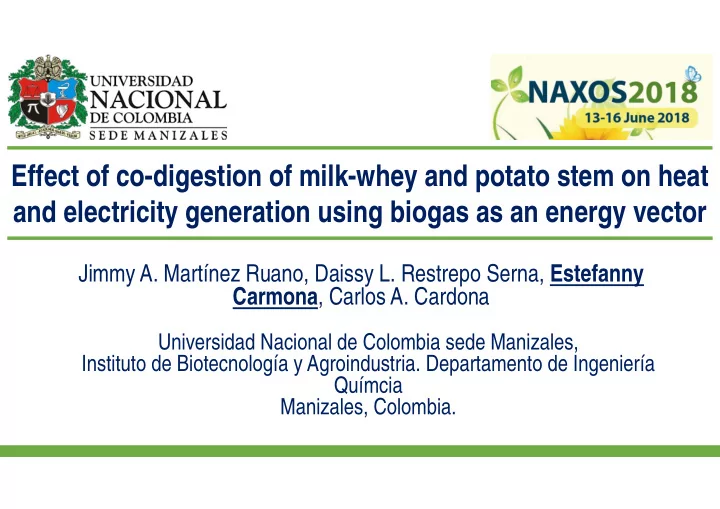

Effect of co-digestion of milk-whey and potato stem on heat and electricity generation using biogas as an energy vector Jimmy A. Martínez Ruano, Daissy L. Restrepo Serna, Estefanny Carmona , Carlos A. Cardona Universidad Nacional de Colombia sede Manizales, Instituto de Biotecnología y Agroindustria. Departamento de Ingeniería Químcia Manizales, Colombia.
Outline o Introduction o Methodology o Results and discussions o Conclusions
Non-renewable energy vs renewable energy Solar Natural Gas Nuclear Wind Energy Energy Hydropower Fosil Fuel Oil Coal Geothermal Biomass Renewable Non-renewable Methodology Results Conclusions Introduction
Biogas as energy vector Biomass Biomethane (CH 4 ) Carbon dioxide (CO 2 ) Water vapour (H 2 O) Hydrogen sulphide (H 2 S) Ammonia (NH 3 ) Methodology Results Conclusions Introduction
Influence of co-digestion on biogas production Co-digestion is the combination of biodegradable raw materials to improve the balance of nutrients in anaerobic digestion. Co-digestion has an influence on the performance of anaerobic digestion, establishing a possibility to increase the potential of biogas as an energy vector. Methodology Results Conclusions Introduction
Aim of research The main objective of this study is to investigate the combined production of heat and electricity from biogas as energy vector using Potato Stem (PS) and Milk Whey (MW). All of this, to determine the economic profit within the framework of the waste integration by anaerobic co-digestion. Methodology Results Conclusions Introduction
Characterization of the raw materials Determination of total solids, volatile solids and ash Particle size reduction ˂ 1 mm Determination of cellulose, hemicellulose and lignin Determination of extractives Methodology Results Conclusions Introduction
Simulation process The production process to generate heat and electricity using biogas obtained from the PS and MW was simulated in Aspen Plus (Aspen Technology, Inc., Houston, USA). Air Biogas Power Anaerobic Energy Electricity Feedstocks Digestion Generation MP-Steam Digestate Hexausted gas Methodology Results Conclusions Introduction
Anaerobic digestion Anaerobic digestion process for biogas production was simulated with a modification of the model: A Novel Process Simulation Model (PSM) developed by Rajendran et. al, 2014. Our model considered the protein of MW as soluble protein and that its lipid composition is mainly triolein.No special pretreatments added. For PS, new reaction was added for extractives, where the extend of reaction is 0.5 ± 0.2 Source from Rajendran et al, 2014. Methodology Results Conclusions Introduction
Heat and electricity The electricity and heat generation from biogas consisted of two sections: electricity production by means of a gas turbine and heat recovery steam generation. Methodology Results Conclusions Introduction
Economic assessment • The process economic assessment consisted of determining the capital costs (CAPEX) and operating costs (OPEX) for each of the simulations. Investment Parameters Tax rate (25 %) Interest rate (17%) Raw materials Potato stem (0.08 USD/kg) Utilities Electricity (0.124 USD/kWh) Operation Methodology Results Conclusions Introduction
Characterization of the raw materials Potato Stem (PS) Milk-whey (MW) Component % % Cellulose 36.03 ± 0.32 - Hemicellulose 27.18 ± 0.40 - Lignin 11.45 ± 0.56 - Extractives 12.47 ± 0.11 - Ash 2.10 ± 0.21 - Moisture 9.67 ± 0.02 94.08 ± 0.32 Protein - 1.43 ± 0.15 Carbohydrates - 3.65 ± 0.37 Fat - 0.19 ± 0.20 Total Solids (TS) 92.63 ± 0.05 5.69 ± 0.06 Volatile Solids (VS) 90.06 ± 0.03 5.38 ± 0.04 Methodology Results Conclusions Introduction
Anaerobic digestion 250 L Biogas/kg feedstock 207.92 200 CO 2 137.73 150 Methane 100 50 21.92 0 MW PS MW + PS Methodology Results Conclusions Introduction
Heat and electricity production AD + CHP Milk-whey (MW) MP steam 7 KW + Milk-whey 266.4 2072.05 Potato stem (PS) AD + CHP 1311.07 MP steam 40 KW + Water dilution 1447.2 Potato stem 2072.05 + AD + CHP PS + MW MP steam 54 KW 1929.6 3383.75 Co-digestion * Balance in kg/day Methodology Results Conclusions Introduction
Economic assessment 40,00 CAPEX 32,00 General and adminsitrative Cost M.USD/year Plant Overhead 24,00 Maintenance Cost 16,00 Operating Labor Cost Total Utilities Cost 8,00 Total Raw Materials Cost 0,00 MW PS MW + PS Methodology Results Conclusions Introduction
Economic assessment 2300 23 Milk-whey (MW) Net Present Value 1800 Potato Steam (PS) 18 Co-digestion of PS and MW (M.USD) 1300 13 800 8 300 3 -200 -2 0 1 2 3 4 5 6 7 8 9 10 11 Year Methodology Results Conclusions Introduction
Conclusions The integration of potato stem and milk whey to generate heat and electricity is a promising alternative due to economic profit. This generates a net economic profit of 17.94 M.USD, which is higher compared to stand- alone process. The biogas yield from potato stem was of 207.21 L biogas/kg PS (66.35% CH 4 ), biogas yield from milk whey was of 21.92 L biogas/kg MW (73.55% CH 4 ) and co-digestion was 137.73 L biogas/kg feedstocks (51.08% CH 4 ). The results represent a type of strategy to analyze the integration of different raw material to reach a synergy allowing increasing the economic indexes for new projects. Methodology Results Conclusions Introduction
Methodology Results Conclusions Introduction
Reactions set Table 2. Reactions for modeling biogas production from potato stem and milk-whey. – Reactions used for PS. – Reactions used for MW. – Reactions used for both feedstocks. Methodology Results Conclusions Introduction
Effect of co-digestion of milk-whey and potato stem on heat and electricity generation using biogas as an energy vector Jimmy A. Martínez Ruano, Daissy L. Restrepo Serna, Estefanny Carmona, Carlos A. Cardona E-mail : ccardonaal@unal.edu.co (C.A. Cardona) Universidad Nacional de Colombia sede Manizales
Recommend
More recommend